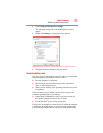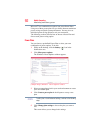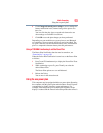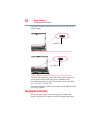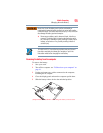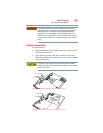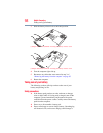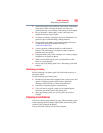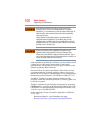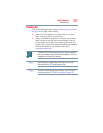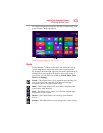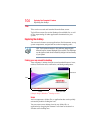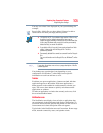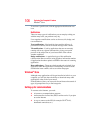
99
Mobile Computing
Disposing of used batteries
❖ Avoid touching the metal terminals of the battery with another
metal object. Short-circuiting the battery can cause it to
overheat and may cause damage to the battery or the computer.
❖ Do not incinerate a spent battery, as this could cause it to
explode and release caustic liquid.
❖ If a battery is leaking or damaged, replace it immediately. Use
protective gloves when handling a damaged battery.
❖ To replace the main battery, use an identical battery that you
can purchase through the Toshiba Web site at
accessories.toshiba.com.
❖ A reverse polarity condition should be avoided with all
batteries. The main battery is designed so that it cannot be
installed in reverse polarity.
❖ Charge the battery only in the computer or in a battery charger
designated as an approved option.
❖ When you install the battery pack, you should hear a click
when it is seated properly.
❖ Do not expose the battery pack to fire. The battery pack could
explode.
Maintaining your battery
Fully discharging your battery pack will allow better accuracy of
the battery meter.
To fully discharge your battery pack:
❖ Periodically, disconnect the computer from a power source and
operate it on battery power until the battery pack fully
discharges. Before doing so, follow the steps below:
❖ If you have extra battery packs, rotate their use.
❖ If you will not be using the system for an extended period,
more than one month, remove the battery pack.
❖ Store spare battery packs in a cool dry place out of direct
sunlight.
Disposing of used batteries
The life of a battery pack depends on usage. When the battery pack
needs replacing, the main battery light flashes amber shortly after
you have fully recharged the battery.
You must discard a battery if it becomes damaged.



